Students’ Guide¶
Content of this document
General Information¶
Prerequisites¶
Stable internet connection
Recommendation: Use a LAN connection if possible.
Browser
Recommendation: Chromium (based), e.g. Google Chrome, newest version.
The following prerequisites are only required if your exam contains programming exercises:
Java IDE with JDK 16
Recommendation: Eclipse IDE 2021‑03.
Git Client
Recommendation: SourceTree
Offline Mode¶
The exam mode in Artemis tolerates issues with the Internet connection.
If you lose your connection, you can continue working on text-, quiz- and modeling exercises, but you might get warnings that your solutions cannot be saved.
If your Internet connection recovers, Artemis will save your solution.
Artemis tries to save your solution every 30 seconds, when you navigate between exercises, and when you click
 or
or  .
.Programming exercises have 2 modes.
Online code editor: can only be used when you are online.
Note
You have to click on
 ! Otherwise your solution will not be pushed to the VC server and no build will be triggered.
! Otherwise your solution will not be pushed to the VC server and no build will be triggered.Local IDE: you only need to be online when you clone the repository and when you push your commits (i.e. submit your solution).
At the end of the online exam, you must be online within a given
grace periodand submit your exam, otherwise it will not be graded.
Suggestions¶
Do NOT reload the browser
If you reload the browser, the Welcome Screen screen opens and you must enter your name and confirm the checkbox again.
You should only reload if an error occurs that cannot be recovered otherwise!
Participate in ONE browser window!
Working in multiple browser windows at the same time is not allowed!
It will lead to synchronization issues and is seen as suspicious behaviour that can be flagged as cheating.

Do not reload, you will receive a warning¶
Participating in the Artemis Online Exam¶
Accessing the Exam¶
Log in to Artemis with your account credentials.
The current exam should be displayed at the top of the Course Overview screen.
You can also access the exam by navigating to the course and then to the exams.
Note
The exam will become visible shortly before the working time starts.
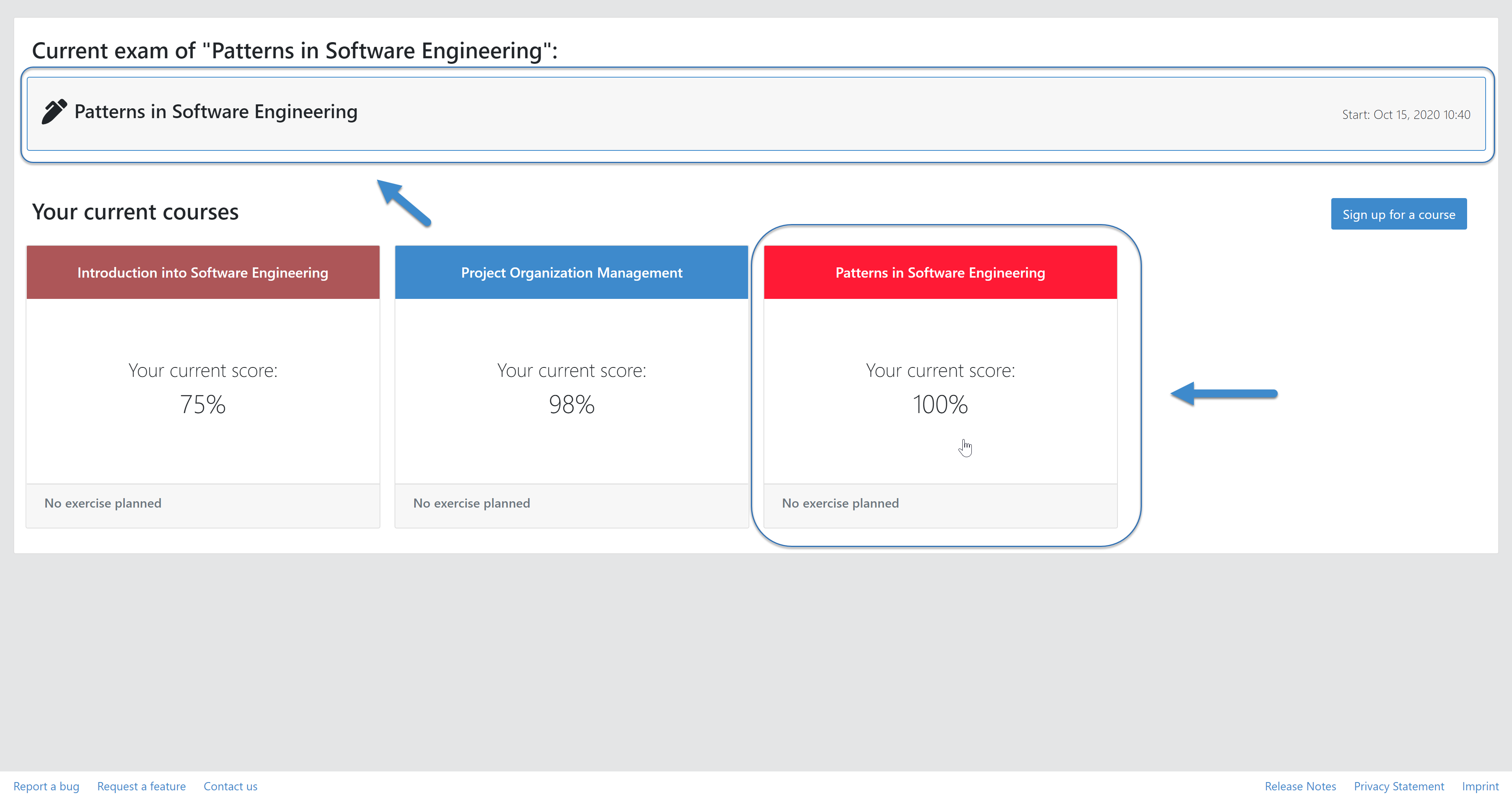
Access Exam¶
Welcome Screen¶
The welcome screen gives you an overview of all the important information you need about the exam.
Carefully read through the instructions.
Once you have read them, confirm that you will follow the rules, sign with your full name and click
 .
.Note
Your full name represents your signature. You can find your full name as registered on Artemis below the input field.
After you confirm, if the exam working time has started, the Exam Conduction screen will automatically appear.
Otherwise, you must wait until the exam begins. A popup will appear which will notify you how much time is left before the planned start.
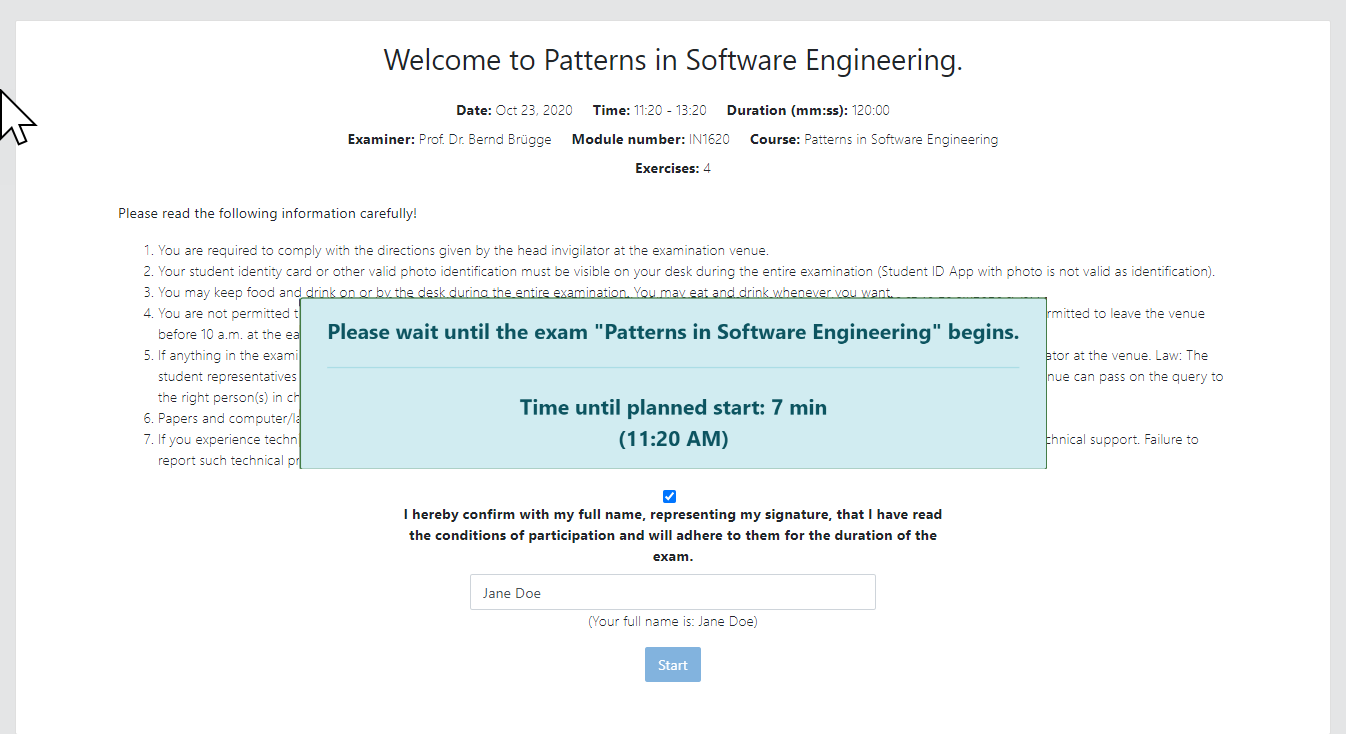
Welcome Screen, waiting for exam start¶
Exam Conduction¶
Once the exam working time starts and you have confirmed your participation, the Conduction screen will appear.
On the header, you will find the Exam Navigation Bar. You can use this bar to navigate between different exercises. For each exercise an icon will display your current status.
When there are unsaved or unsubmitted changes, the exercise representation on the navigation bar becomes
 .
.When your changes are saved and submitted, the exercise representation on the navigation bar becomes
 .
. indicates that you have not started this exercise.
indicates that you have not started this exercise.
You can also navigate through the exercises when you are done with one by clicking
 . This action will save and submit your changes and move to the next exercise.
. This action will save and submit your changes and move to the next exercise.Warning
For programming exercises, you must manually press
 otherwise your solution will not be counted!
otherwise your solution will not be counted!On the header, you will also find the
 button. If you press this, you will be sent to the exam End Screen.
button. If you press this, you will be sent to the exam End Screen.The time left until the end of the exam is also shown next to the action buttons, or below, depending on your screen size.
Note
When the time is about to run out, the background of the timer will turn yellow to warn you.

Exam Navigation Bar¶
Participating in Quiz Exercises¶
Various question types can be included in quiz exam exercises. These are:
Multiple choice questions
Short Answer questions
Drag and Drop questions
All questions are listed in the main screen below one another.
To navigate between them you can either scroll or use the
question overviewon the left. When you click on one of the question representations, your view will automatically scroll to the respective question.To submit your solution, simply press
 .
.Note
Your submission will automatically be saved every 30 seconds.
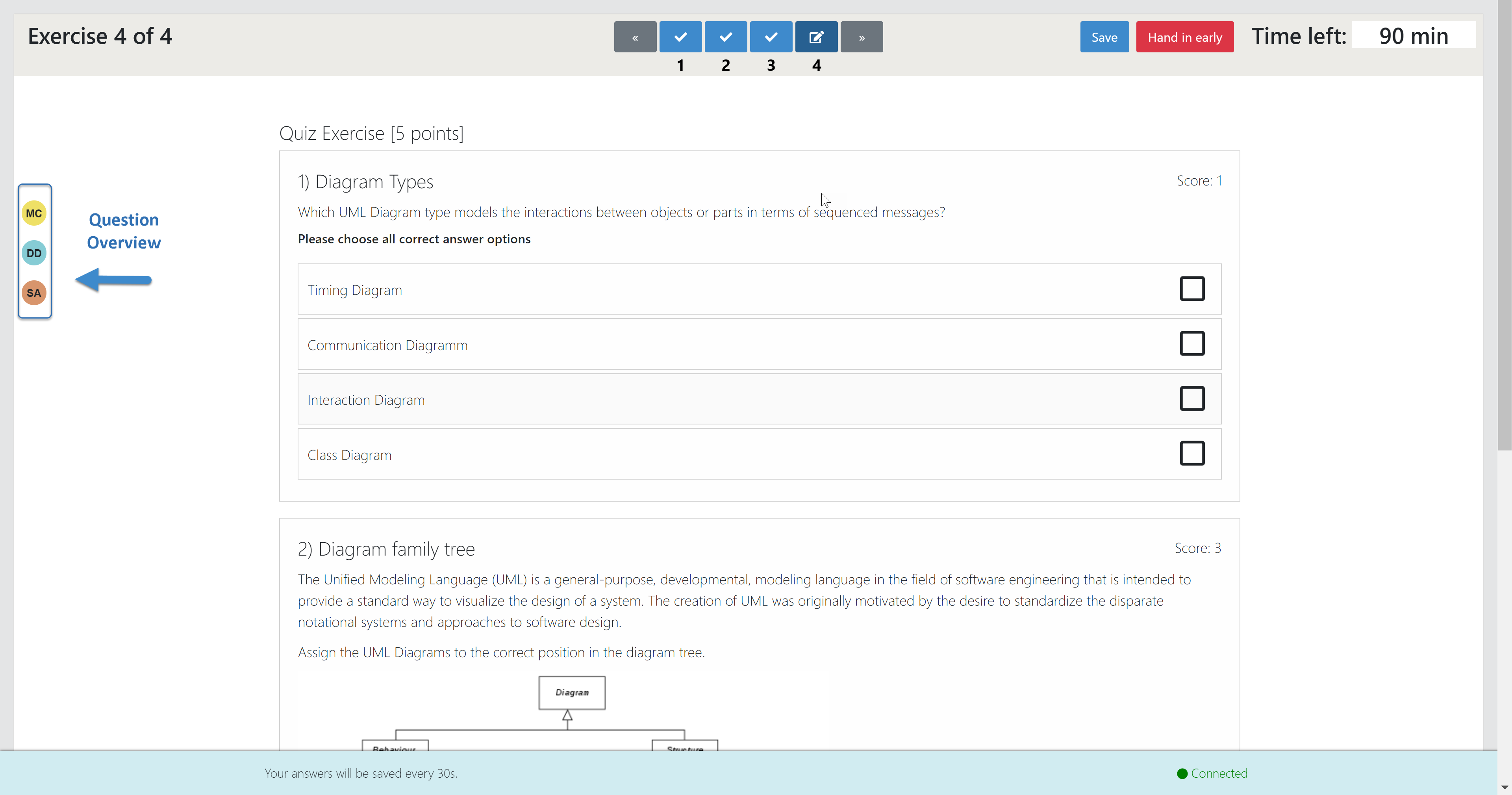
Participating in Quiz Exercises¶
Participating in Text Exercises¶
The text exercise view is divided into two sections, the text editor, and the problem statement. The problem statement is docked to the right.
Note
On small screens, the problem statement is shown above the text editor.
If you want to focus only on the text editor, you can collapse the problem statement by pressing on
 . This can be reverted by pressing the arrow again.
. This can be reverted by pressing the arrow again.Note
You can also choose to resize the problem statement by dragging the outline box
 .
.Within the editor you can type out your solution. The editor will automatically track your number of words and number of characters.
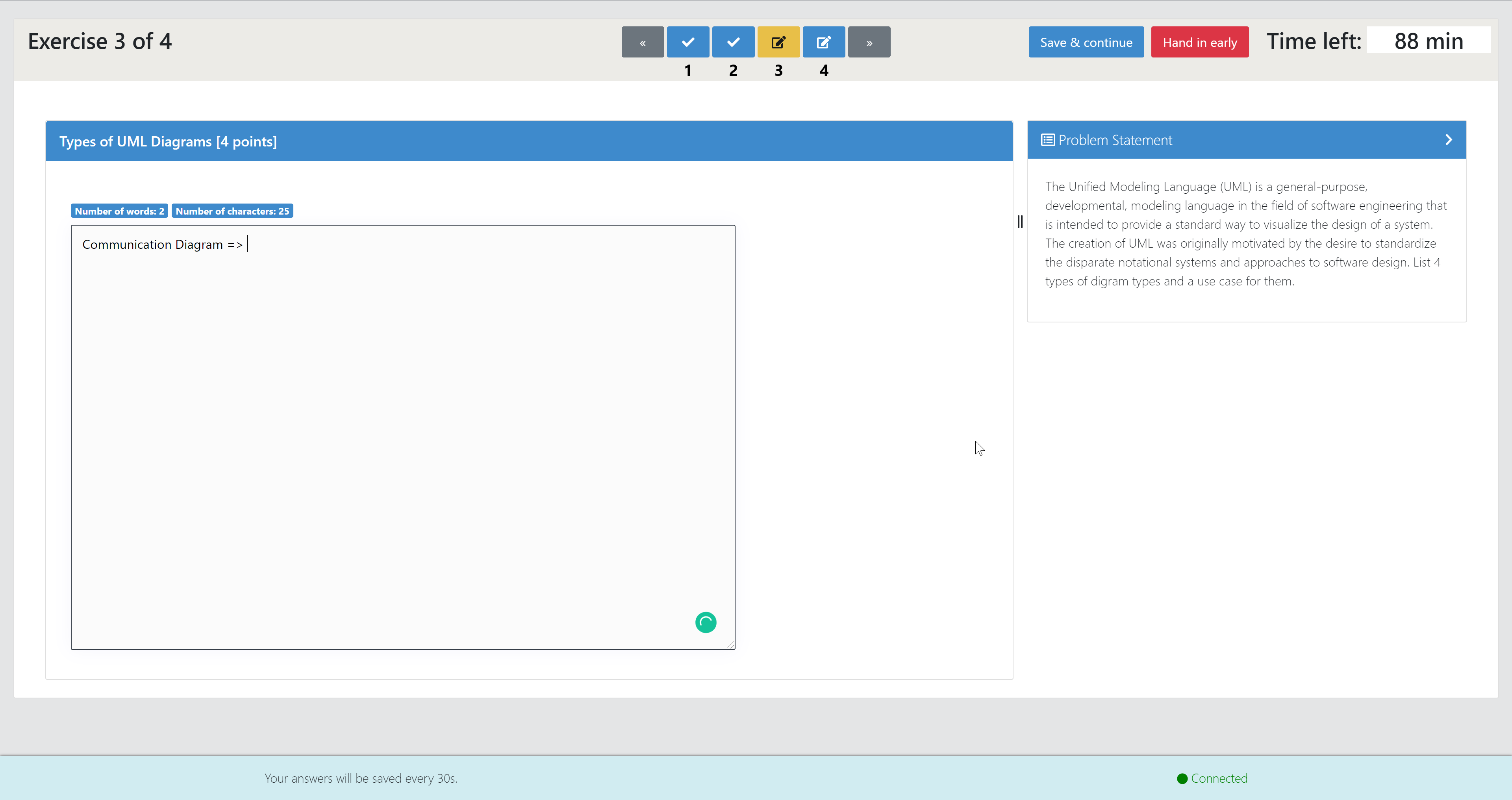
Participating in Text Exercises¶
Participating in Modeling Exercises¶
The modeling exercise view is divided into two sections, the modeling editor, and the problem statement. The problem statement is docked to the right.
Note
On small screens, the problem statement is shown above the modeling editor.
If you want to focus only on the modeling editor, you can collapse the problem statement by pressing on
 . This can be reverted by pressing the arrow again.
. This can be reverted by pressing the arrow again.Note
You can also choose to resize the problem statement by dragging the outline box
 .
.Within the editor you can model your solution. Depending on the diagram type, you will find the available elements on the right side of the editor. Simply drag and drop them into the editing field.
When you click on a dropped element, you can configure it by setting it’s
name, it’sattributes,methodsetc.To connect elements you can simply drag an element’s edges to another element. The editor will then automatically connect those two.
If you are unclear about how to use the modeling editor, you can click on
 . It will provide further information about how to use the modeling editor.
. It will provide further information about how to use the modeling editor.Note
If you need more space, you can work in fullscreen by clicking on
 . This mode will use your whole screen for the modeling exercise thereby giving you more space to model your solution. To exit the fullscreen mode simply click
. This mode will use your whole screen for the modeling exercise thereby giving you more space to model your solution. To exit the fullscreen mode simply click  .
.
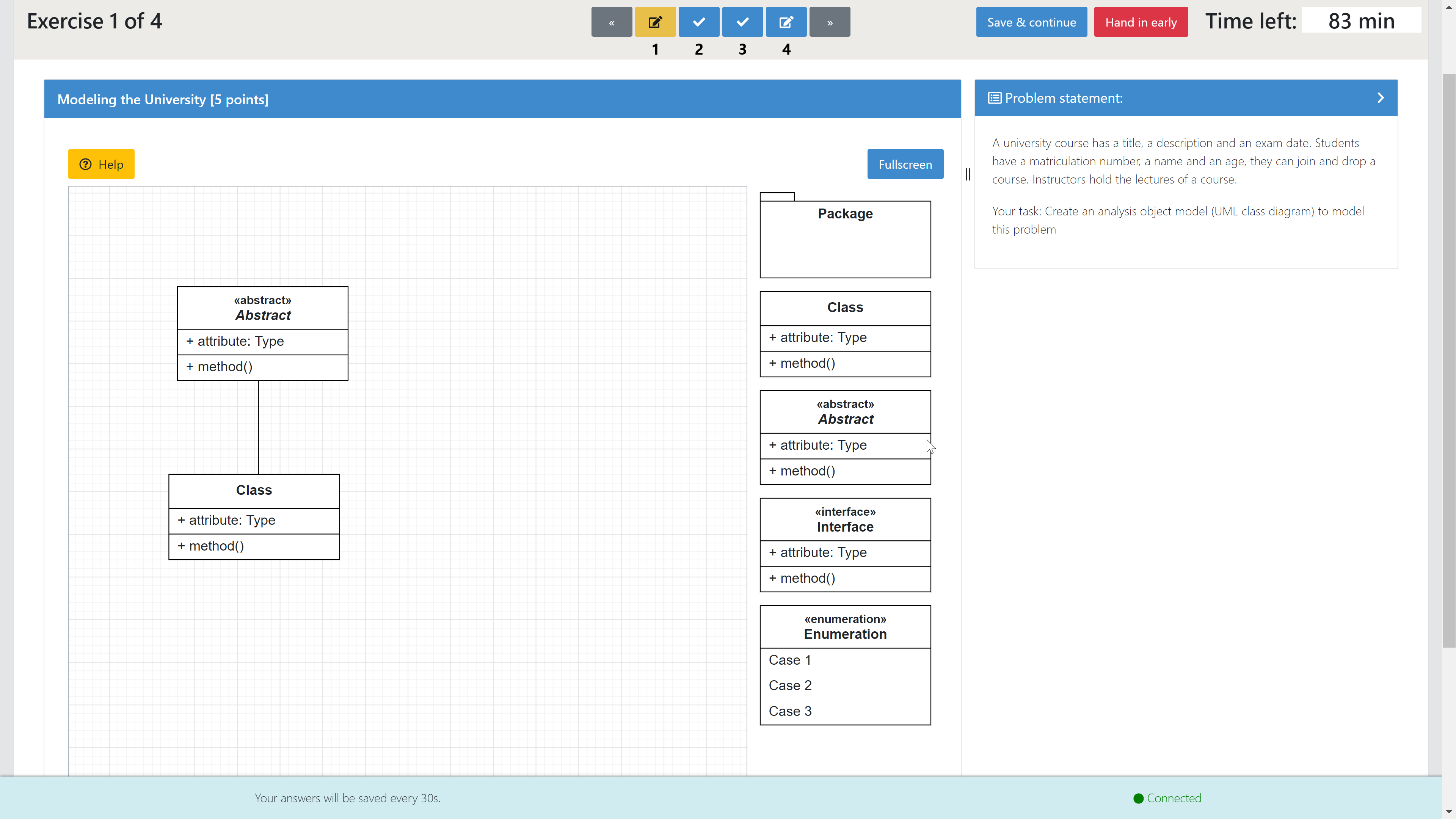
Participating in Modeling Exercises¶
Participating in Programming Exercises¶
Depending on your exam, programming exercises can come in three forms:
Online Code Editor + support for local IDE
Online Code Editor
Support for local IDE
If your exercise allows the use of the code editor your screen will be divided into three sections, from left to right:
The file browser
The code Editor
The instructions
The file browser displays the file structure of the assignment. You can access any file within the assignment. Artemis will display the selected file’s content in the code editor where you can edit it.
You can add new files and directories using the
 and
and  buttons.
buttons.You also have the ability to rename
 and delete
and delete  files and folders, therefore caution is advised.
files and folders, therefore caution is advised.Note
If you accidentally delete or remove a file, you can use
 , to load the last saved version from the server.
, to load the last saved version from the server.
The code editor allows you to edit the content of specific files. It shows the line numbers and will also annotate the appropriate line, if a compilation error occurs.
The instructions are docked to the right.
If you want to focus only on the code editor, you can collapse the instructions by pressing on the
 . This can be reverted by pressing the arrow again. Similarly, if you want to collapse the file browser, you can press the
. This can be reverted by pressing the arrow again. Similarly, if you want to collapse the file browser, you can press the  above the file browser.
above the file browser.Note
You can also choose to resize any of the three sections by dragging the
 .
.When you press
 , your files are saved on the Artemis server. However, you must press
, your files are saved on the Artemis server. However, you must press  for your solution to be counted!
for your solution to be counted!When you press
 , your changes are pushed to the version control (VC) server and a build is started on the continuous integration (CI) server. This is indicated by the results changing from
, your changes are pushed to the version control (VC) server and a build is started on the continuous integration (CI) server. This is indicated by the results changing from  to
to  .
.Warning
There is no auto-submit!
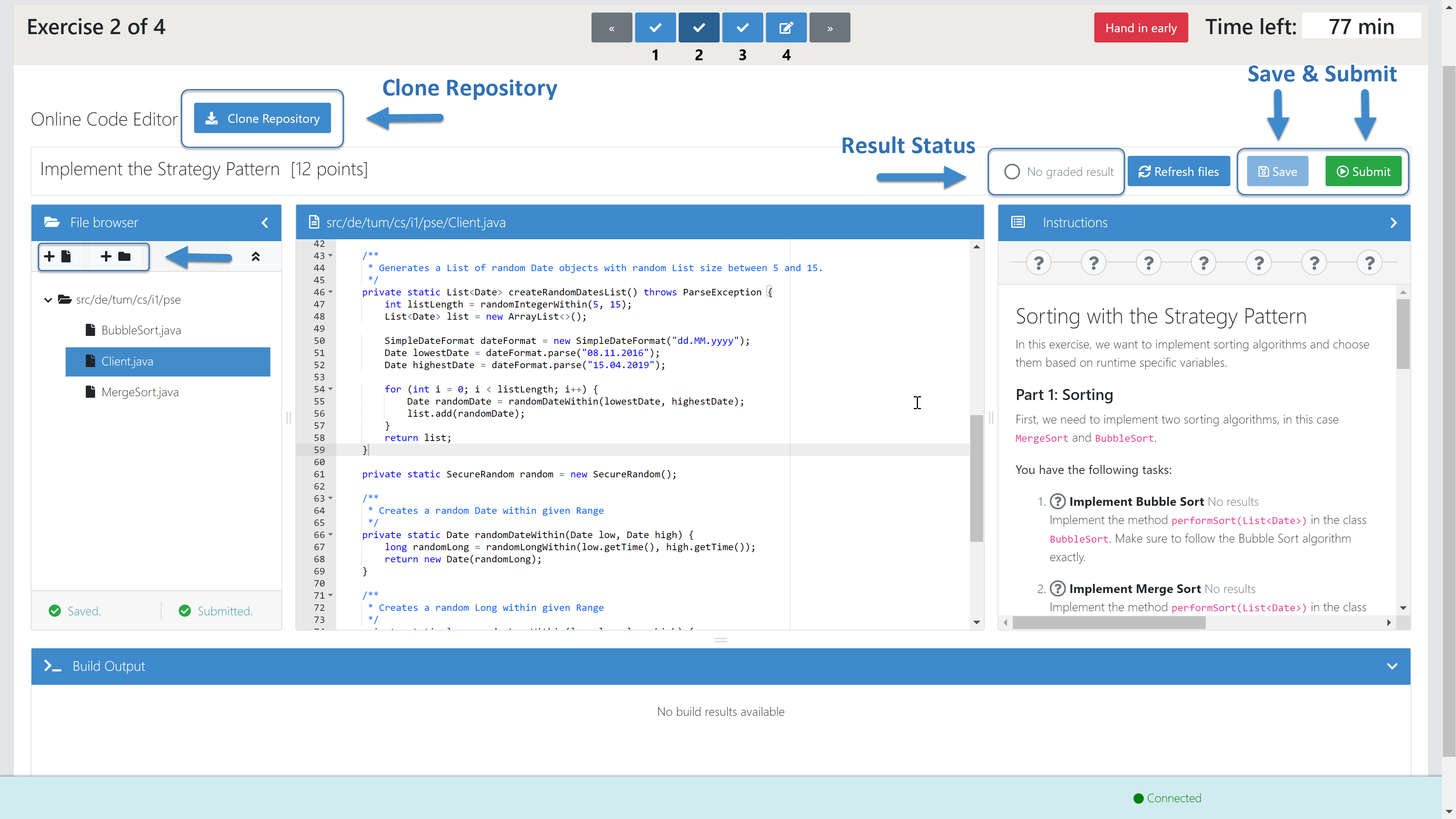
Participating in Programming Exercises with the online code editor and local IDE enabled¶
If your exercise allows the use of the local IDE you will have access to the button
 .
.When you click it you can choose to clone the exercise via
HTTPSorSSH, if you have configured your private key.Note
You must link a public key to your account in advance if you want to use
SSH.To work offline follow these steps:
Clone the Exercise
Import the project in your IDE
Work on the code
Commit and push the code. A push is equivalent to pressing the
 button.
button.

Clone the Repository¶
Warning
You are responsible for pushing/submitting your code. Your instructors cannot help you if you have saved, but did not submit.
Your instructors can decide to limit the real-time feedback in programming exercises during the online exam.
In that case, you will only see if your code compiles or not:
 means that your code does not compile!
means that your code does not compile! means that your code compiles but provides no further information about your final score.
means that your code compiles but provides no further information about your final score.
Warning
Edit a programming exercise EITHER in the online editor OR in your local IDE! Otherwise, conflicts can occur that are hard to resolve.
End Screen¶
When you are finished with the exercises, or the time runs out you navigate to the End Screen.
This is done either by clicking on
 or automatically when the exam conduction time is over.
or automatically when the exam conduction time is over.Note
If you navigated to this screen via
 , you have the option to return to the conduction by clicking on
, you have the option to return to the conduction by clicking on  .
.In this screen you should confirm that you followed all the rules and sign with your full name, similar to the Welcome Screen.
You are given an additional
grace periodto submit the exam after the conduction is over. This additional time is added to the timer shown on the top right.Warning
Your exam will not be graded, should you fail to submit!
Once you submit your exam, no further changes can be made to any exercise.
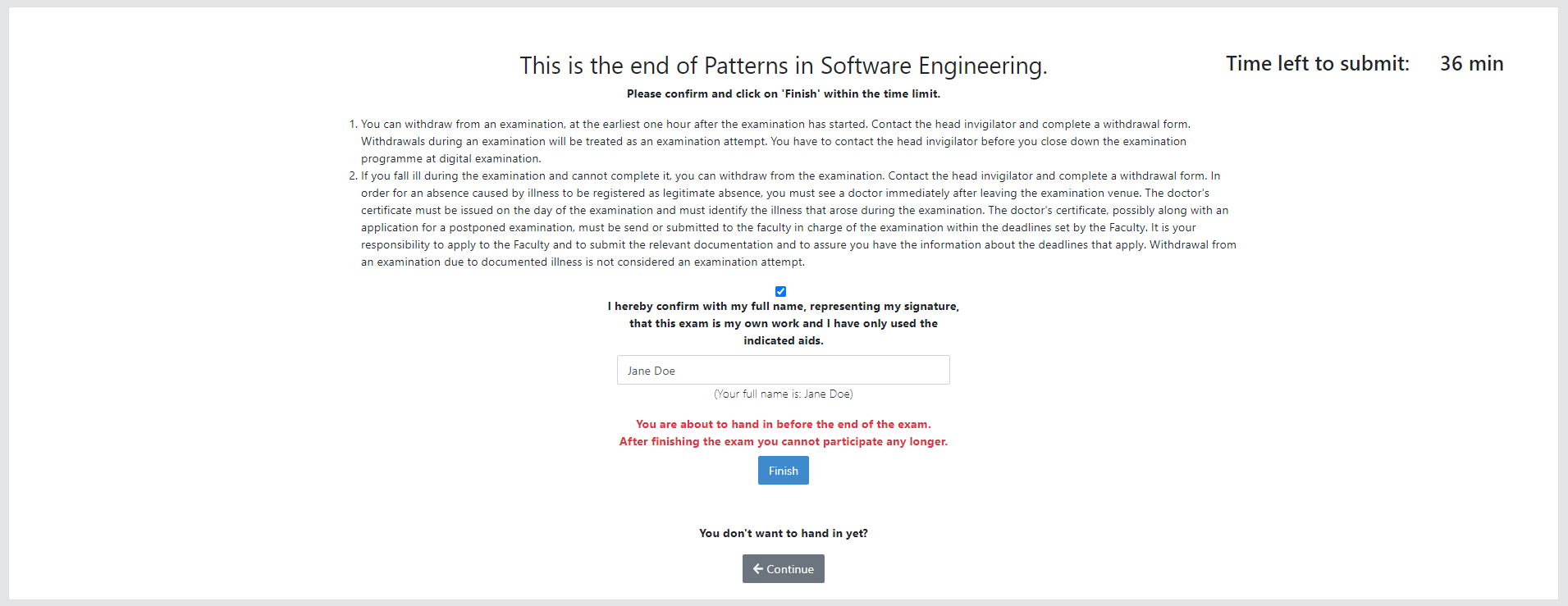
End Screen after Early Hand in¶
Summary¶
After you hand in, you can view the summary of your exam.
You always have access to the summary. You can find it by following the steps displayed in: Accessing the Exam.
Further you have the opportunity to export the summary as a PDF file by clicking on
 .
.The summary contains an aggregated view of all your submissions. For programming exercises, it also contains the latest commit hash and repository URL so you can review your code.
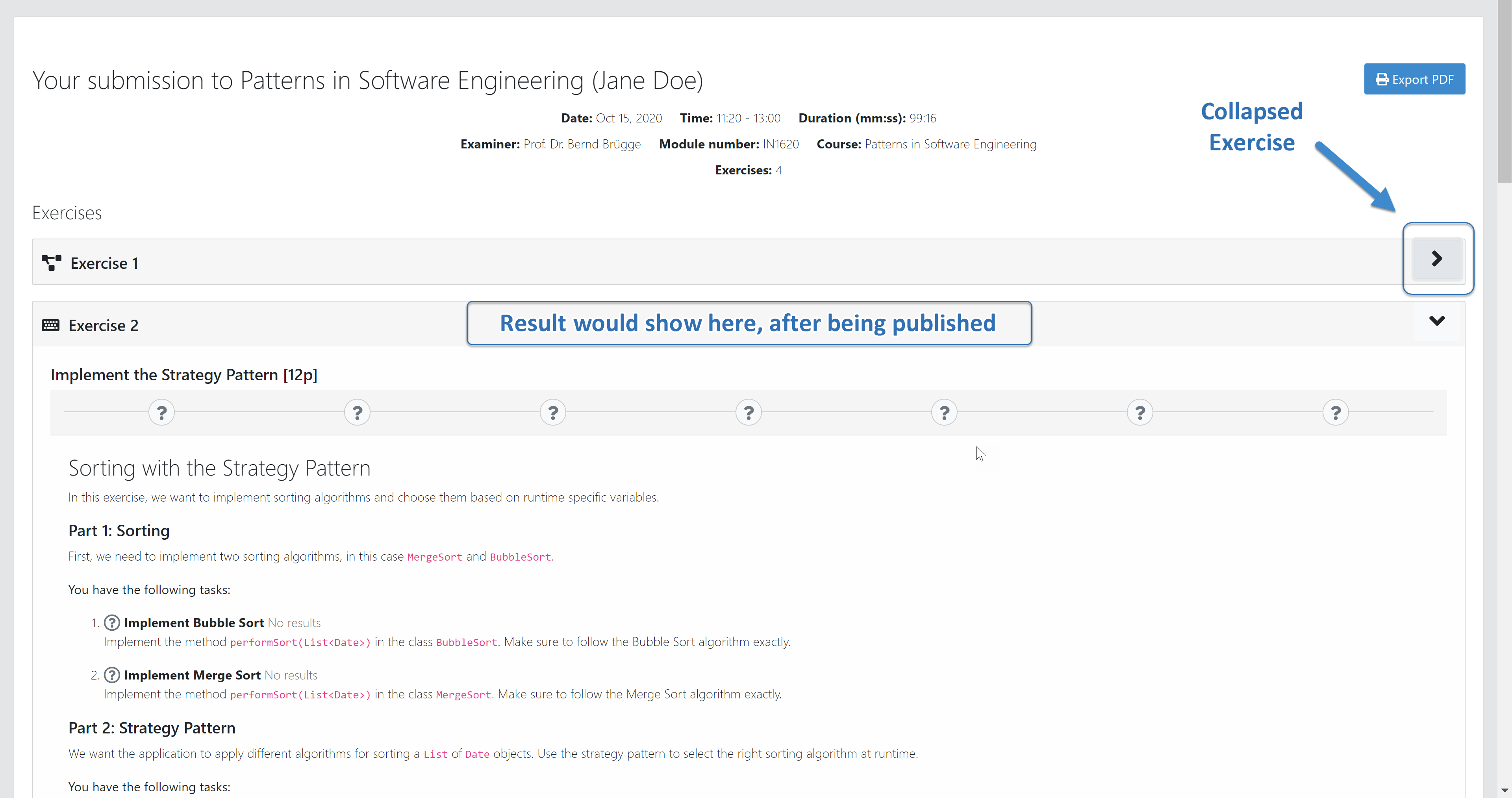
Summary before the results are published¶
Once the results have been published, you can view your score in the summary.
Additionally, if within the student review period, you have the option to complain about manual assessments made. To do this, simply click on
 and explain your rationale.
and explain your rationale.A second assessor, different from the original one will have the opportunity to review your complaint and respond to it.
The complaint response will become visible to you as soon as it has been assessed.
Again, you can export the summary including your score as a PDF file by clicking on
 . The PDF will also contain any complaints and complaint assessments.
. The PDF will also contain any complaints and complaint assessments.Note
The results will automatically be updated, if your complaint was successful.
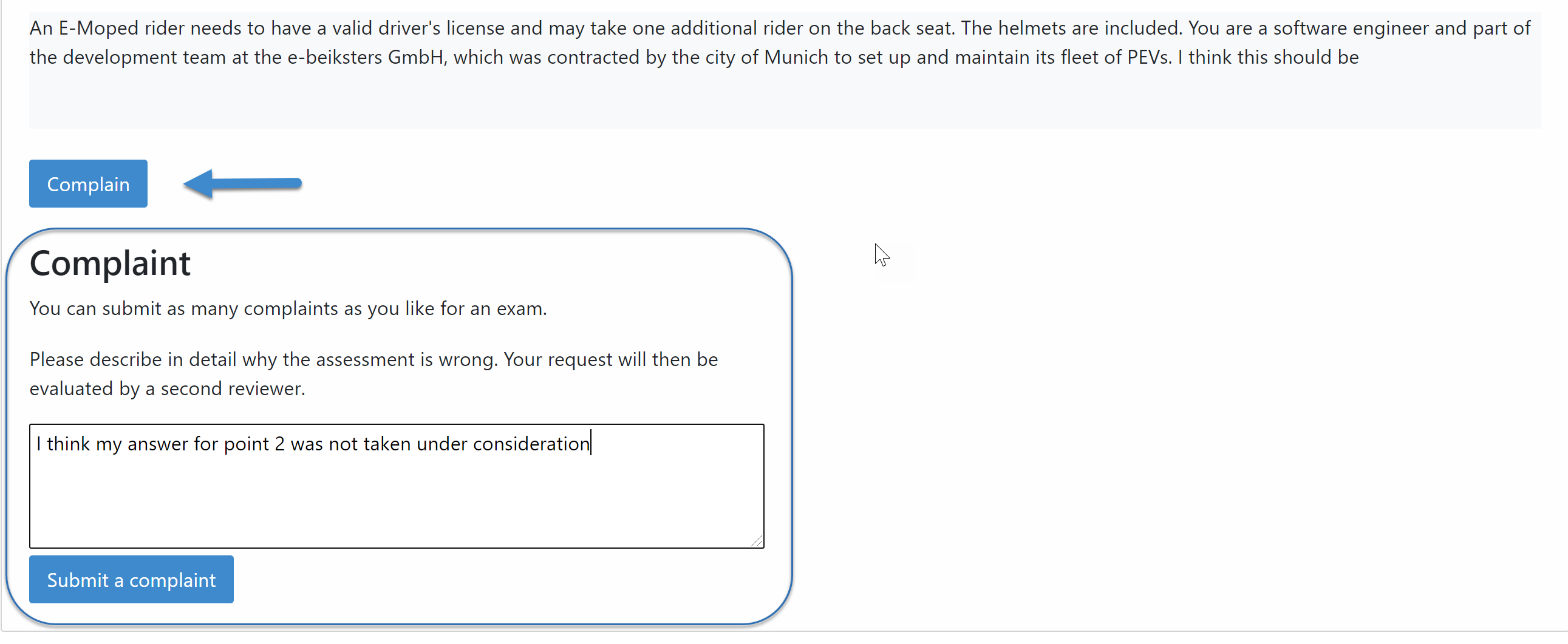
Complaining about the Assessment of a Text Exercise¶